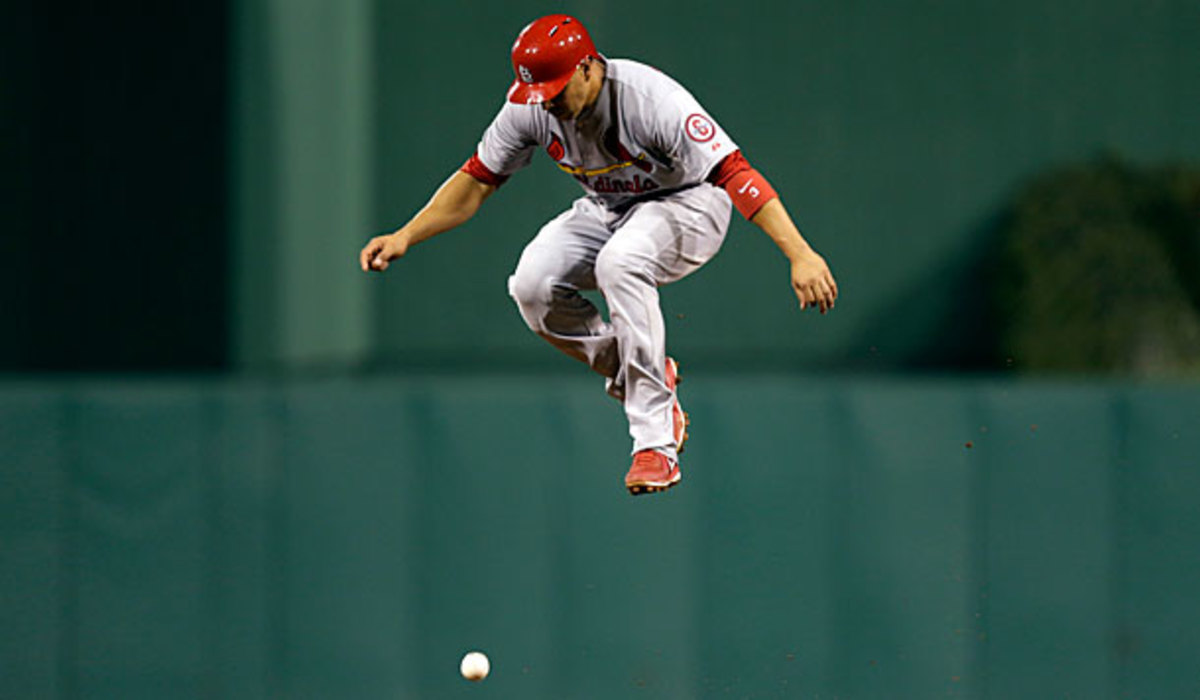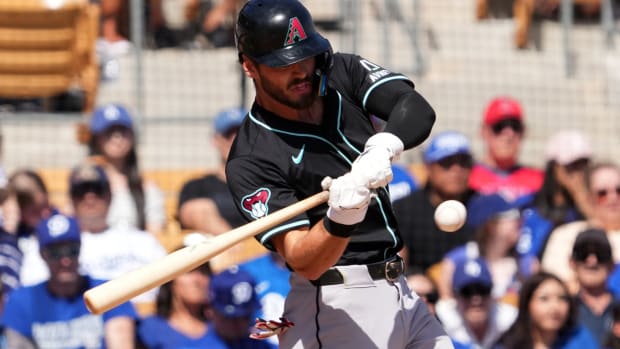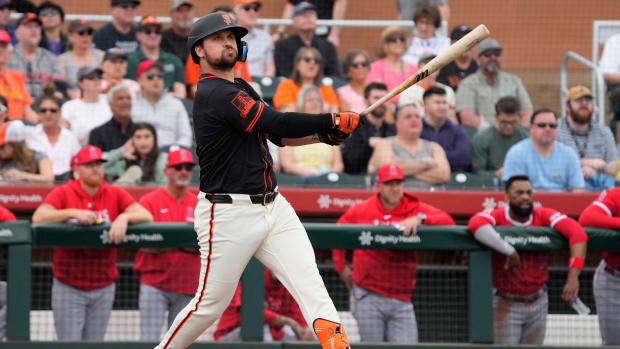Signs of weakness: Flaws that could derail NL contenders
The Cardinals need Carlos Beltran to make a big jump back to his All-Star form down the stretch. (Gene J. Puskar/AP)
As the recent hot streaks of the Braves and Tigers distanced themselves from the regular season pack, I turned an eye towards the playoffs to identify both teams' weaknesses going forward. Since then, the fields in the two leagues have continued to consolidate; the National League has about a 1-in-8 chance of somebody outside the current three division leaders and two wild-card teams crashing the party, though the American League is more like 1-in-2.
As the teams jockey for position down the stretch, here's a quick look at the factors most likely to derail each one on the way to the playoffs and beyond. I'll start with the NL, and since I've already hit the Braves, the teams are listed in reverse order of their current Baseball Prospectus Playoff Odds.
Arizona Diamondbacks (64-58, 1.6% division/9.5% wild card/11.2% playoffs)
On July 7, the Diamondbacks led the NL West by a season-high 4 1/2 games but since then have gone just 17-17, and they now rates as the league's most credible longshots (sorry, Nationals, your 1.2 percent chance doesn't merit discussion here).
Not surprisingly, Arizona's multiple weaknesses aren't hard to identify. The rotation has just two pitchers who have made a full complement of starts, and the considerable depth with which the team entered the season has been squandered by injuries and the ineffectiveness of established veterans like Trevor Cahill (4.78 ERA) and Brandon McCarthy (4.84), the questionable trade of Ian Kennedy to the Padres on July 31 and the underperformance of prospect Tyler Skaggs (5.12 ERA in seven starts). The unit's 4.01 ERA ranks 10th -- nearly half a run behind every other contender here -- while its 54 percent quality start ranks ninth; now that McCarthy and Cahill are back, the D-backs will need more than the four wobbly starts of 4.91 ERA work they've gotten from those two this month.
Save for the decline of setup man David Hernandez (5.59 ERA), the bullpen has rounded into shape since Brad Ziegler took over at closer. The 'pen now has the league's fourth-lowest ERA (3.25) and lowest rate of allowing inherited runners to score (23 percent). A far bigger problem is injuries to the lineup. The underperforming Miguel Montero (.228/.316/.345) has been out since July 28 due to a bulging disc and is only just beginning a rehab assignment in the rookie-level Arizona League. While backup Wil Nieves has hit .340/.355/.429 this year, his .402 batting average on balls in play isn't likely to hold up. Meanwhile, the loss of Cody Ross (.278/.331/.413) for the season due to a dislocated hip knocked out the most productive outfielder from a group whose .715 OPS (on .262/.321/.395 hitting) ranks 13th in the league. With Adam Eaton (.242/.321/.326) and Martin Prado (.278/.331/.409) covering leftfield, it would help if rookie third baseman Matt Davidson (.278/.348/.484 at Triple-A Reno) showed the form that made him the Futures Game MVP.
Cincinnati Reds (70-54. 26.4%/67.7%/94.1%)
With a 10-5 record this month, the Reds have closed their gap in the NL Central from six games to 2 1/2 while growing their lead for the second wild-card spot from four games to five, though that's only boosted their odds by 2.6 percentage points. Still, there's room for improvement, particularly as it could mean the difference between the crapshoot of the wild-card game and an automatic berth in the Division Series. While Cincinnati has survived the loss of Johnny Cueto thanks to rookie Tony Cingrani's strong work (2.60 ERA and 10.4 strikeouts per nine in 15 starts), Homer Bailey has become particularly homer-prone since his July 2 no-hitter, allowing 1.5 per nine in eight starts, only four of which have been quality outings.
Lineup-wise, while the return of leftfielder Ryan Ludwick from a dislocated shoulder should help shore up a position where the team has gotten just a .239/.305/.371 performance. Meanwhile, a return to form from the normally reliable backstop Ryan Hanigan (.201/.312/.283) and last year's unsung hero Todd Frazier (.234/.326/.392 with 12 homers) could boost an offense that already ranks fourth in the league in scoring at 4.30 runs per game.
St. Louis Cardinals (71-52, 33.4%/63.4%/96.8%)
From July 26 through Aug. 10, the Cardinals went 4-13 and lost 6 1/2 games in the division standings. That streak didn't precisely coincide with Yadier Molina's trip to the disabled list (July 31–Aug. 14) for a right knee sprain, but there's little doubt the team missed its MVP-candidate backstop, who has hit .328/.371/.488 and yielded just two passed balls and 18 stolen bases in 96 starts. He returned to action on Thursday and went 4-for-9 with three doubles over the weekend, but manager Mike Matheny will have to make sure he doesn't overwork him down the stretch. The same goes for rookie starter Shelby Miller (2.97 ERA in 127 1/3 innings), though thanks to a 13-day break around the All-Star Game and a two-pitch outing induced by a scary comebacker, he's now on pace for just 173 innings, a reasonable step up from his previous high of 153 1/3.
Beyond that, the biggest concern may be that the offense has simply sagged in the second half, from .276/.337/.416 and 4.97 runs per game to .253/.318/.367 to 4.43 runs per game. In addition to Molina's absence, Allen Craig (.234/.333/.299) and Carlos Beltran (.271/.308/.417) have been the most tepid of the previously productive starters (we'll skip Pete Kozma), and in fact no Cardinal has more than two homers in the second half. Against playoff-caliber pitching, a team that ranks 13th in the league in longballs (95) and 12th in isolated power (.133) could struggle to piece together the longer rallies necessary for big innings that the opposition can match with a single swing of the bat.
Pittsburgh Pirates (72-51, 40.2%/57.3%/97.5%)
That elusive .500 season is now just nine wins away, but the Pirates obviously have bigger accomplishments in mind. Alas, they've gone just 21-21 since the beginning of July and have lost seven of their last nine, with their NL Central lead whittled from four games to one and the specter of the previous two years' agonizing collapses continuing to loom. While Jose Tabata (.269/.344/.409) has helped shore up the team's lack of production in rightfield since returning from an abdominal strain in early July, Garrett Jones and Pedro Alvarez haven't helped the offense much beyond the occasional longball in that span, hitting just .220/.289/.422 and .217/.276/.422, respectively.
Thanks to the strong work of Mark Melancon (0.78 ERA with one earned run allowed since June 4), the bullpen has remained one of the league's best despite the loss of Jason Grilli, who's eying a Sept. 1 return from a forearm strain. A bigger problem may be the regression of the rotation in the second half, particularly with regards to Jeff Locke (5.58 ERA, 6.2 BB/9, .406 BABIP in six starts). In fact, the BABIP of the unit as a whole has risen from .277 before the All-Star break to .334 since, a rise that has something to do with the offense/defense tradeoff of playing Jordy Mercer (.277/.331/.402, −1 Defensive Runs Saved) instead of Clint Barmes (.226/.269/.318, +9 DRS) at shortstop.
Los Angeles Dodgers (72-51, 98.4%/0.8%/99.1%)
With a 42-8 run -- tying the 1941 Yankees and 1942 Cardinals for the best 50-game stretch of the past century -- the Dodgers have looked virtually unbeatable in recent weeks, but they're hardly flawless. As has been the story all year, their biggest issue is injuries. In fact, just two position players, Adrian Gonzalez and Andre Ethier, have even played in 100 games thus far due to dents and dings if not bigger injuries. Ethier (.270/.351/.408) has offset his own loss of power and the continued absences of the underpeforming Matt Kemp by holding his own in centerfield (-3 DRS in 49 games), but he remains a liability against lefties, hitting just .233/.266/.357 in 139 PA. Carl Crawford (.247/.307/.358 in 88 PA) hasn't been much help there, either. The potential crowd created by Yasiel Puig and a healthy Kemp could alleviate that, but the latter may not be back from his ankle sprain until September.
While Hanley Ramirez (.356/.405/.635 in 65 games) seems none the worse for wear since being limited to one pinch-hit appearance in 10 days due to a shoulder injury, his every nick threatens to knock out a player who would be under MVP consideration if he could remain healthy. As Sunday's loss to the Phillies showed, defense isn't his strongest suit, though at least within the sample size of 49 starts at shortstop, the numbers are in his favor (+2 to +5 runs in all four major defensive metrics).
As the additions of the erratic Carlos Marmol and the ever-distracting Brian Wilson have shown, the team continues to try to address the workloads of the bullpen's big three of Kenley Jansen, Ronald Belisario and Paco Rodriguez, all of whom rank in the league's top seven in appearances with between 60 and 62. Monday's activation of Wilson could spread some innings around, though what the team can expect in his return from Tommy John surgery after just 4 1/3 innings of rehab work remains an open question.
Atlanta Braves (76-48, 100.0%/0.0%/100.0%)
Since covering the Braves in this context nearly two weeks ago, they made a solid attempt to shore up a weakness by sending second baseman Dan Uggla (.186/.307/.389) to the DL for LASIK surgery, but over the weekend, they lost fill-in Tyler Pastornicky to a torn ACL. That leaves light-hitting Paul Janish (.214/.285/.287) to man the position, but that's a short-term problem.
Their biggest issue remains the workloads of their effective but relatively inexperienced rotation, the current starting five of which (Mike Minor, Kris Medlen, Julio Teheran, Brandon Beachy and Alex Wood) has combined for exactly one major league season of more than 25 starts and 150 innings, that by Minor last season. By the time that quintet reaches October, they'll be in uncharted territory, innings-wise, a problem that should be particularly concerning with regards to the 22-year-old Teheran, who has a staff-best 2.96 ERA. He's on pace for 195 innings, which would push well past his previous career high of 164 1/3 innings, set in 2011, and demolish last year's 137 1/3 innings. Those are exactly the kind of huge jumps that teams prefer to avoid. Even accounting for his improved performance, he's on pace to face 813 hitters, a 38 percent increase over his previous high.




































